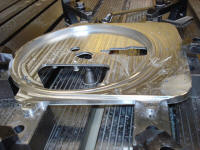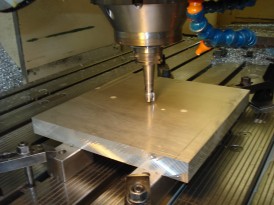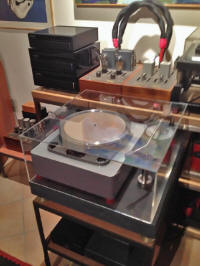-edible zone-
Quote\ I looked forward to TRULY gorgeous results... the most difficult task is keeping "that" Garrard feeling, NOT going on unknown paths... like creating a new freak, a Frankenstein: not looking for obtaining a wannabe Micro or a Verdier, actually;-)! All must be carefully balanced and cared for... new, bespoke plinth, spindle, platter, mat, stainless-steel springs set, intermediate idler-wheel... like in a recipe for a great dish, difficulties and expense and effort must not over-shadow or make redundant the final result... ALL must "click" together and sound easy and effortless... and, possibly, better - I mean MUCH better - than a stock Garrard 301;-))) A Garrardzilla. /Unquote
The above words are those of the man who produced the subject of this
article. His name is Stefano Bertoncello. He lives in his native
Northern Italy. His online moniker is Twogoodears. (abbr:TGE) and he has
an audio blog of the same name. Here's a link: http://www.twogoodears.blogspot.com
Now we know why the name. To find out what Garrardzilla actually is
and how it came into existence continue reading.
It was not
without some small amount of surprise when I encountered a photo of it.
The first glimpse of that photo caused me a double-take. A Garrard 301.
That much was evident. It was mounted into a heavy plinth with a
separate stand-apart arm pod....both pieces were finished in an
automotive silver enamel. I've seen plinths with separate arm pods like
these often enough before. Always high mass. The arm on top of the pod I
hadn't seen before. Just looking, the effective length appears longer
than what is typically seen in the 12 inch category. And the platter. I
could identify its material as bare machined bronze. They certainly
didn't come that way originally. Lathe-turned bronze, taller than stock,
but of a diameter not much more than the original platter. The 301
aluminum chassis was finished in gray hammer-tone enamel and appeared
flawless. Perhaps the chassis had had a re-paint, …...or at least that
is what I thought.
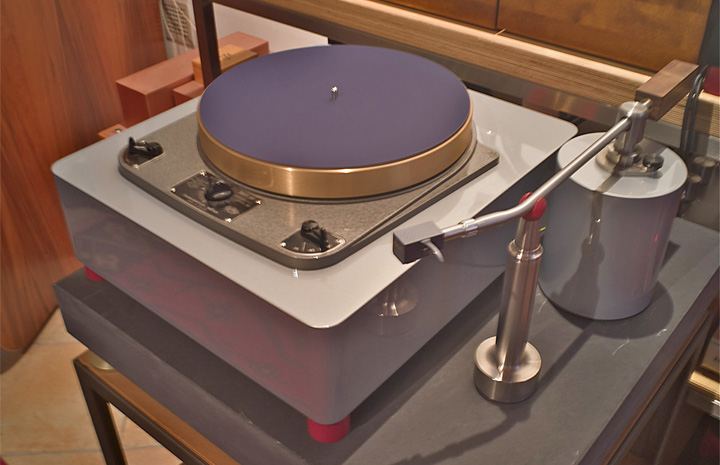
Shindo came to mind. But the platter wasn't at all like anything I've
seen by Shindo.
Those were my thoughts until I started looking
for some facts. There was some text in accompaniment with the photo.
That text told me something of what I wanted to know, but not enough to
fully describe what it really and truly was that I was looking at.
I could certainly send TGE an email and just ask. Eventually I did.
But I knew about the audio blog. Maybe I'll just search through the
pages of his blog because he tends to document many of his projects
there, I thought. And my plan became 1: research the blog, then 2: ask
questions. And what I learned from the blog was quite a bit. In fact it
supplies enough information to fully describe this rig mechanically and
how it sounds to its owner's ear. Good info there.
Here's what I
dug up:
The cast alloy chassis isn't cast. It is cnc milled from
a solid block of aluminum by Ray Clark.
The bronze platter we see so
prominently on top weighs 29.7 lbs. (13.5Kg)
That blue platter mat up
topside is a Shindo 800 grams leaded cloth mat.
Under that platter is
a spindle bearing that looks like its been taking regular doses of
steroids
Stock motor with new stainless steel isolation springs
Slate plinth....massive slate, with stand-alone and also massive arm pod
Tonearm: It is "The Peak" heavy mass 16-inch and was chosen specifically
to work with a Japanese built Lumiere DST cartridge.
When I sent
an email asking my questions his reply indicated that this project was
A:a very personal search for musical satisfaction and B: Not a business.
All the better I thought.
From what can be seen of its exterior,
the above describes this beast in general terms. There is much more data
on this particular project player.
The
Bearing: Shindo, Commonwealth, Westrex 12D*, Garrard 301, EMT
930st. Those spindle bearings were studied in detail prior to arriving
at a design goal for this project. Classic Hi-Fi also produces a bearing
upgrade for the Garrards 301and 401. Yet the goal for this project
required a bearing suitable for supporting a load heavier than any
platter offered by Classic Hi-Fi or Shindo. So this is what was made:
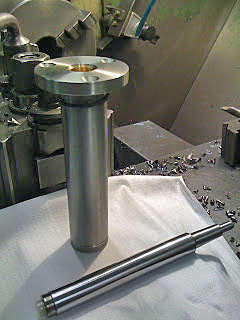

Above: On the left is the Garrardzilla bearing housing and shaft. On the right is a stock Garrard spindle bearing standing upright next to the Garrardzilla bearing. The difference between them is apparent. That difference being “Length”. The Garrardzilla bearing is 40mm longer than the stock part. Additionally, the spindle pin is longer to compensate for taller/thicker platter mats and also to work with different record clamps that might be used. A very limited batch of this design was produced with intent that no more will be made. A local machinist was chosen to produce these.
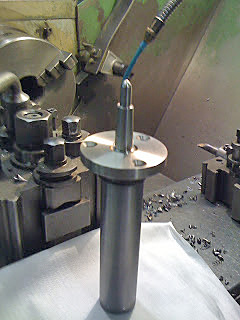
Both housing and spindle shaft are stainless steel.
From
the blog: Quote/ ...my bearing uses a cool mix of exotic Kluber
(made in Austria) super expensive lithium/molybdenum grease and
compatible oil, making it a grease bearing design. This apparently
silly, small choice makes a world of difference in sound... the rotation
time-before-stopping decreased, but time isn't everything... the vibes
control and taming in EVERY sensitive area IS the goal! /Unquote
*footnote: re: bearings opened while design of the Garrardzilla
bearing was underway: TGE's comments about the 12D....Quote/ The
bearings opened, studied and measured included Commonwealth/Westrex 12D
- i.e. Commonwealth from Australia built the now sought after idler
wheel turntable under Westrex patent...My own 12D is now residing in
Berlin, in Thomas Schick's hands... after "things" are done, no need to
stuff shelves and shelves of unused gear;-) /Unquote.
An Idler Wheel
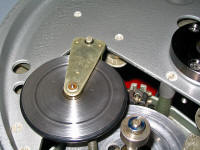 (hint:
click on thumbnail to view full size image)
(hint:
click on thumbnail to view full size image)
Above: custom machined idler wheel for Garrardzilla.
Material is
stainless steel.
Bushings are sintered bronze.
Rectified O-ring
wt: 250 grams.
The Platter:
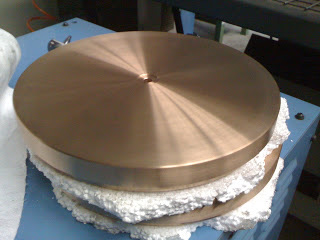
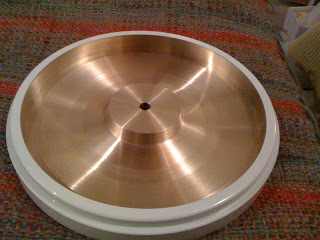
Above: Custom platter in B19 bronze turned by a local machinist.
There were a few of these produced. And then no more.
Quote\ ….precision and being heavy duty enough to be used with the 13,5
kilos platter… using bronze isn't by chance… stainless-steel or brass
aren't giving same sound… I tried them and beside being cheaper and
beautiful, shiny, their vibration frequencies aren't the same… bronze is
darker, like live acoustic music is… and VERY dynamic and quick…/Unquote
Quote\ Every parameter of the several 301's strengths was
GREATLY improved: impressively dynamic and smooth, surprising at every
spinning... the added, improved mass and fly-wheel effect sure helps,
supports and improves the spinning stability, both mechanically and
aurally... the notes decay is of SELDOM heard beauty and quality...
looooooong and extremely various, with a world of ever changing
harmonics. As I leave platter running for hours and hours, never
stopping its running but if I have to change speed for some - rare - 45
rpm discs, when I finished my listening session I finally gave off to
the Garrardzilla;-) and, you won't believe... my hand light touch almost
wasn't able to stop the spinning platter... an enormous apparent weight
was felt by my fingers.../Unquote
One was coated heavily
with white enamel, while leaving the underside bare. The other was left
entirely bare. ( Editors note: 13.5 Kg is 29.7 lbs to us folks in North
America! ) For reference The original Garrard 301 cast aluminum platter
weighs 2.3Kg. The Classic Turntable Company's oversized bronze platter
weighs 10Kg. The Shindo machined aluminum platter weighs 6.7 Kg.
Garrardzilla: 13.5Kg.
TGE Quote\ Yes, the 13,5 kilos bronze
platter is the heaviest around... BUT the bronze and silky careful ultra
precise machining made THE difference vs. stainless steel and brass
platters... shiny, but sonically lesser... as materials and their
frequency resonances are paramount and weight alone isn't enough.
/Unquote
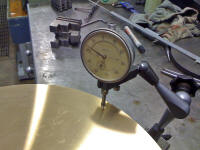 checking machined platter for runout. (hint: to view full sized photo
click on thumbnail)
checking machined platter for runout. (hint: to view full sized photo
click on thumbnail)
At one point there came a question; Does stressing the standard
Garrard 301 chassis with the additional weight of the bronze platter
(13.5Kg), and the more massive bearing designed for it, have a positive
or negative effect on the presentation being heard. His observations:
Quote/ The 12 kilos bronze platter used in the heavy duty,
super-smooth giant spindle/bearing both inserted in stock 301's
turntable add a brand-new feature to the whole: the added mass gives a
"seen" at chassis level "virtual mass" where the flimsy thickness of
original Garrard's alu alloy chassis get a stress due to
weight........snip..........At molecular level, the centered almost
five-times multiplied mass of new spindle and platter give about same
results than a turntable whose chassis weights 10/12 kilos with - maybe
- a better vibes taming character!........snip..............Having
access to a laboratory quality gears using, say, photoelastic stress
analysis techniques, all the above should be VERY visible and apparent
and clear.......snip.......The sound, are you asking?!?... don't know,
folks... the stressed structure of Garrardzilla sure gives "more" to
music... it's clearer, truer, it's... "is".... and this counts./Unquote
Ultimately this question and observations lead to Classic Turntable
Company for its 301 Solid chassis. This chassis offers greater rigidity
than the original lighter cast chassis and thus is able to handle the
greater loads encountered when using heavier platters and bearings.
Below: the CNC milled 301 chassis is offered by Classic Turntable
Company, Classic Hi-Fi Shop in the UK and its director, Ray Clark.
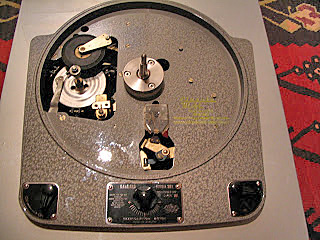
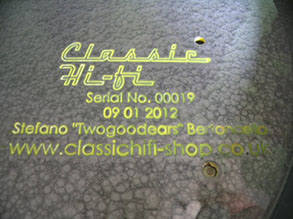
The next pair of photos (above) are the subject 301of this article.
The owners name and moniker, can be seen just below the serial number
and date of manufacture in the last photo, above right.

What makes these cnc milled chassis more stout and more rigid than the original cast chassis can be seen from underneath. Lacking in ribs and valleys, the overall thickness of the Classic Hi-Fi 301 Solid is uniform and holds much more metal while maintaining the same outer dimensional envelope as stock. This results in a more rigid and heavier frame.
(hint:
click on thumbnail to view image full size)
Above: underside of a Classic 301 solid milled chassis. (Photo taken at random from the net)
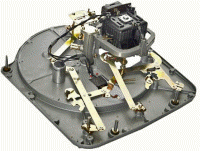 An
original chassis build for comparison.
An
original chassis build for comparison.
After the 301 mechanicals, (including Garrardzilla's oversized
bearing and platter), were installed into the Classic Solid 301 chassis
TGE gave his project a listen. What follows are his comments.
TGE Quote/ ... (speechless mode)...It's all and more I remembered and
missed for the last weeks, despite the truly superb Lenco's sonic
footprint... the original, stressed 301's chassis is doing well, BUT the
full optional Garrardzilla, including Ray's part and elegant, 401-like
underside screws is a completely different beast... still more dynamic,
with a resolution which only a bunch of us on the Planet experienced,
period. No hypes... The notes decay with every instrument, solo or in a
jazz quartet or trio is awesome... also if I only listened to three
records, this morning... Sidsel Endresen's on ECM with those crazy
shimmering cymbals and piano, Anthony Bailes' lute on EMI Reflexe for
tiniest resolution and ambient retrival and Ludwig Streicher double bass
and piano on Telefunken for explosive dynamics... all came soooo
naturally and beatiful and quick and beefy and undistorted! /Unquote
TGE Quote\ Ray Clark's Solid Chassis is a BIG part in Garrardzilla's
project... love its 401-style screws system, more elegant than stock
301's.... but the sound, THE SOUND is really awesome vs. stock
chassis!/Unquote
Tonearm
Choices
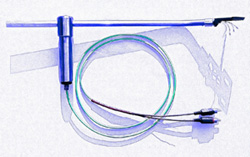
Looking at photos of the tonearm I made some visual assessments.
These 'impressions' ranged from: I haven't seen this arm before.....
and….It appears on the longer side of 12 inch effective
length........and.......it looks heavy..........and........no
anti-skate....and.......I wonder who made it, etc. Given that I was
coming up with all questions and no answers I asked TGE the following
question:
Q: (the analog dept) In my research of your project I
noticed some components I haven't seen before; 1) The Peak Heavyweight
tonearm and 2) the Lumiere DST cartridge. What I've learned about the
Lumiere DST is that it is a reincarnation (of sorts) of the Neumann DST
from many years past. The Lumiere has a similar coil configuration to
that of the NeumannDST but with an entirely different suspension design.
Its suspension design more closely resembles that of a mastering lathe
cutter. (take a look at JVC Cutter) I presume The Peak heavy arm became
necessary in order to make a better compliance match onto the Lumiere
DST and its ultra-stiff suspension, and to better handle what must be
significant spurious energy generated at the stylus-groove interface in
this configuration.
A: TGE Quote/ The Peak, with the "The"
it's sonically and to my ears, ahem... the peak in my arms stable,
period. Consider the arm was conceived by myself and hand-built by my
good friend and lathing & mechanic artist Mario, in Italy, painstakingly
auditioning different bearings, Abec 7 and 9 and arm wands materials -
i.e. two different thickness aluminium, titanium, stainless steel and
brass tubes... the contenders were FR 66-S, Ortofon RMG 309i, James
Grant's from New Zealand Cocobolo arm wand unipivot arm and Thomas
Schick's... all 12" designs with different should, from smooth,
forgiving, romantic sounding, to the quick responsiveness of the best...
The Peak arm uses Panzerholz/bronze rear weight with two decoupling
O-rings inside....this seldom seen solution has great sonic merits too.
The Peak surpassed all the contenders!
The cartridge of choice
remained the fussy Lumiere DST, the one and only to give me the
zestiness I need vs. my own and played real instruments and live music
experiences.
The Peak – thanks to its careful balance and
building care in sensitive areas, like the heavy mass headshell SME
screw-mount area - is able to play incredibly well, effortlessly and
with a sense of rightness, the heaviest dynamic grooves with a seldom
heard, if unique, aplomb... but without losing the finesse, the
detailing and introspective character I always loved sooooo much! The
Lumiere DST and its musicality - in use since 2005 - was completed when
I found an N.O.S. Neumann DST white cartridge which sounded REALLY great
despite its 50 years old vintage. /Unquote
TGE Quote\ The Peak
wires are 60 years old vintage Litz wire from headshell to phono
plugs...my good friend Lo who carefully made the twisting of the four
Litzes spent about two days of annoying twisting. Imagine twisting hairs
to obtain 130 cm (35 cm inside the wire and 95 cm outside it)....a
nightmare!! You need patience and a Zen-like attitude....Lo is the most
Zen guy I know! Avoiding a signal interrupting in the cable using Litz
of minute AWG is paramount. /Unquote
TGE Quote\ The
VTA base of The Peak is an original Fidelity Research B-60, as used in
my FR 66-S amd 64-S....having two and being that the above mentioned
arms are unused now....I'm using with the Peak....very cool Gizmo.
/Unquote
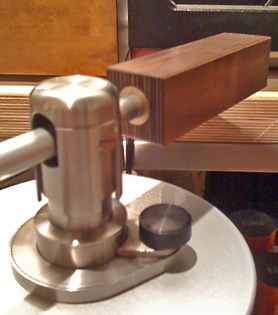 The FR B-60 vta base holds the Peak tonearm
The FR B-60 vta base holds the Peak tonearm
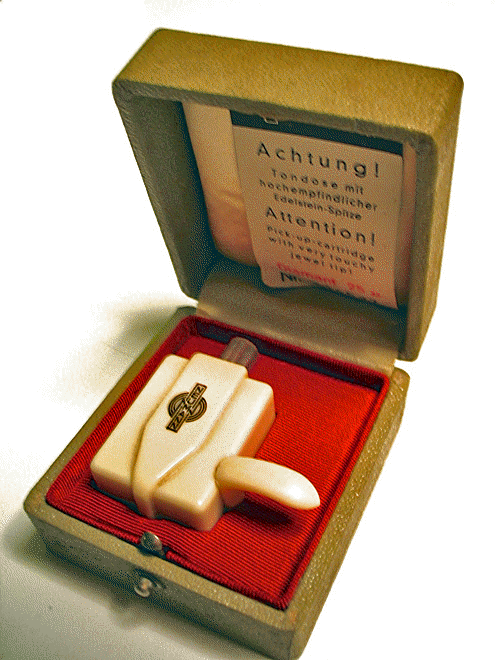
Above: a NOS Neumann DST (white)
fyi, vtf settings: Lumiere DST: ~3.5grams.....Neumann DST: 5 to
6grams.
The plinth comes in two pieces. A main base, (45 Kg) and
a separate arm pod (bronze, 25 Kg). The main base is solid slate coated
in Jaguar Silver Grey enamel. The armpod is lathe-turned bronze and also
coated in the Jaguar enamel. It stands its ground firmly planted by
means of its considerable mass......plus gravity ;-)
Standing on a dedicated steel stand for the turntable, the slate
plinth resides over another shelf of massive slate. The separate arm
pods are lathe turned from solid B19 bronze. Each pod weighs 25 kg (55
lb). Properly footed, these aren't going to move. The advantage is very
good mechanical isolation from the motor unit itself. With the separate
pod arrangement it is possible to have more than one arm in use with the
turntable simply by placing another pod with arm mounted in a suitable
location around the plinth. There just needs to be enough free area
about the turntable for the pod to stand.
Accessories.
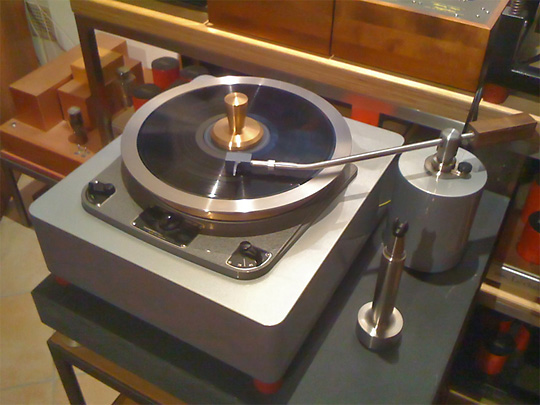
For accessories we see it with a TT-weights Peripheral Ring (480 grams) and a 850 gram record weight produced by TGE. In the above photo we can't see which mat is in use so I asked which platter mat was favored and got a response indicating that the 'Blue' leaded cloth 800 gram platter mat from Shindo, a Suede mat from Jean Hiraga , A Micro Seiki 2.8kg CU-180 mat are used alternatingly, depending on mood. That seems about right with my experience. How many of us, myself included, swap out platter mats just to hear the difference in presentation!
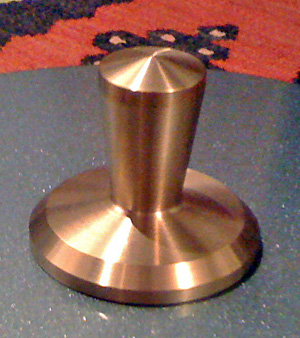 Custom record clamp (TGE's design)
Custom record clamp (TGE's design)
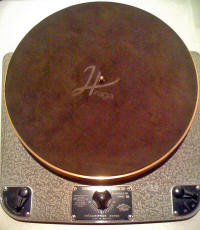 Garrardzilla with Jean Hiraga Suede mat
Garrardzilla with Jean Hiraga Suede mat
(hint: click on thumbnail to view image full size)
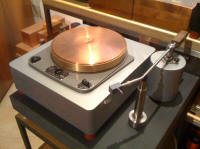 Micro Seiki CU-180 mat on Garrardzilla.
Micro Seiki CU-180 mat on Garrardzilla.
re: The Peripheral Ring: In one blog post TGE reminisced how,
for a time, he had tired of using the peripheral ring due to the
repetitive efforts and ceremony involved in its use. And so the ring had
gone unused for a period...... long enough for dust to accumulate about
the peripheral ring at its assigned shelf space. Then the TTW peripheral
ring was put back into use. He says the difference in sound, that is
with ring -vs- without ring, had to do with an even lower noise floor,
improved dynamics, richer textures and improved sense of effortless and
liquid flow.
Conclusions:
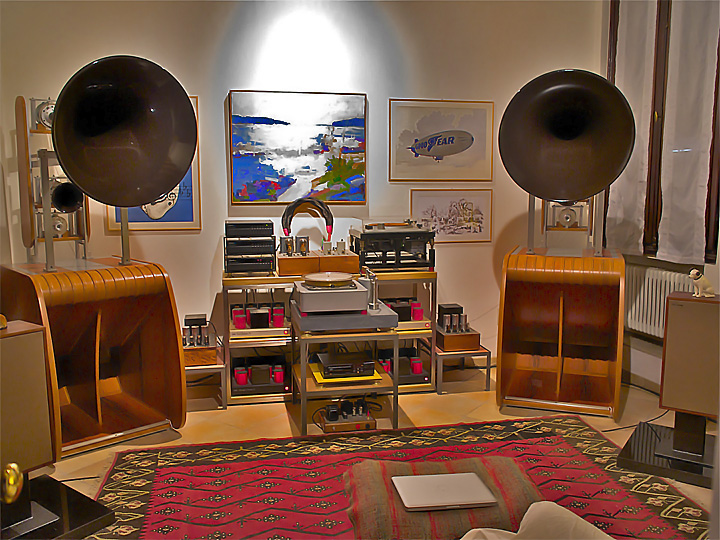
Above photo: from behind the listening chair.
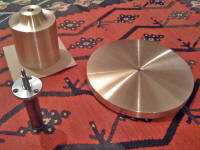 The three components that define it.
The three components that define it.
This ends the description of Garrardzilla and how it came into being.
(article continues below)
Please note that TGE has asked me to
state that duplicate parts made during this project have already been
sold and that no more are scheduled to be made again. And now I add the
following comments regarding where some of the 'prototype' parts went.
TGE Quote\ Thanks for pointing it out about the commercial
unavailability of these bespoke parts... yet, I'm very, VERY proud that
a handful of my prototypes are in use in very exotic audio systems of
friends who wished to follow my vision... all these gents owned The Very
Best gear available... and agreed (and still agree) about the uniqueness
of a Garrardzilla combo. /Unquote
Postscript: The
Garrardzilla project took place over a period of years dating from 2010.
Many intermediate steps, and also some of the parts designed, built,
tried and then not selected are not documented here. The intent has been
to describe the finished product and to include descriptions of some
parts that are worthy of mention.
Prior to beginning this project
TGE had been using both a Shindo platter with matching bearing, a Shindo
leaded cloth 800 gram mat After confirming the qualities of his
Garrardzilla bearing and bronze platter, he chose to sell the
aforementioned Shindo platter and its bearing. However the Shindo
platter mat was retained.
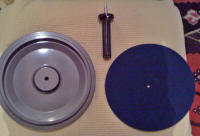
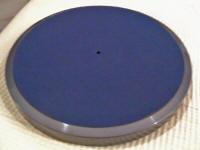 Shindo platter, bearing and lead cloth mat.
Shindo platter, bearing and lead cloth mat.
(hint: click on thumbnail to view full size photo)
TGE noted that the machined aluminum Shindo platter was delivered
painted on all surfaces, under and outer, and left with a slightly
uneven surface for the idler wheel to turn against. This is a detail TGE
gave consideration to, with the Garrardzilla B19 platter, and made
certain that a true spinning bare metal surface of very fine surface
roughness was present for the custom idler wheel to drive. A critical
area for any idler driven turntable.
One of the questions I asked
was whether or not any dedicated power supply or speed control
electronics were tried. His answer was that the stock Garrard motor and
pitch control have been retained and he notes further that the motor
seems well suited to the additional platter weight and sees no urgent
reason to pursue any electronic motor control.
The EMT 930st. In
the system pic. In the background is seen the EMT 930st standing within
its seismic base on the component stand against the back wall. It might
seem only logical to assume the superiority of the EMT over any other
turntable in the room. However TGE sees (and hears) it differently.
In a blog post from December, 2011 he states the following:
Quote\ Swapping tables, arms and cartridges dramatically made me
aware of the EMT's shortcomings... pleasant, smooth and "radiophonic",
in the sense it always reminds me when - I learned it after years - the
930st was "the" radio workhorse... its sound was... is no spikes, no
dips, let's say average sounding... a concept I already expressed
several times:-)
930st vs. 301 seems such a nice match... but
unfortunately (not for yours truly...) it's a true lesson for myself my
friends and everyone who doesn't believe that a table (and arm and
cartridge) owns a soul: the music flows freely and effortless, light to
the ears... never tiring... /Unquote
Other platter
materials:
The B19 bronze platter was the final result of much
testing. There were platters turned in stainless steel and aluminum. But
then Prior to the B19 platter there had been a custom platter lathe
turned from a rather large and expensive piece of Panzerholz multi-ply.
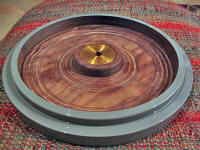
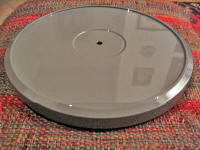 (hint: click on thumbnail to view full size photo)
(hint: click on thumbnail to view full size photo)
Above two photos: A Garrard 301 platter machined from Panzerholz. Outer surfaces coated heavily with enamel.
Stefano's comments on the sound using different platters from
different materials:
Quote\ …...used Delignits Panzerholze 330
mm disc (expensive!) Took to local machinist to have turned to Garrard
301 dimensions. With bronze insert at center to improve precision and
bearing matching. Painted outer surfaces. Inner surfaces, including the
inner rim that engages the idler wheel were left bare.” “Incredibly a 13
kg bronze platter sounds quite similar to a 3.5 kg Panzerholze platter
and both sound – you bet it – so different from original alu alloy
platter, which seems to lack – after direct comparison – that slam,
oomph and guts, and the greatly improved decay…. …The Delignit’s plywood
detailing is less exagerated vs. bronze’s very “severe” incredible
retrieval capabilities…. ,yet, acoustic instruments and classical string
quartets, acoustic guitars and voices are amazing with Panzerholz./Unquote
By now the reader knows that the B19 bronze platter was the final
choice. However the Panzerholz experiment is definitely interesting.
Others have used this material in platter construction. Favorable
comments seem to surround this material.
The intent of this
article has been to look into the original thinking and imagination
behind one very serious Garrard 301 project. As stated at the outset,
TGE's goal was to retain the essence of the original player while
extending its abilities to venture into qualities of playback its
original designer could not have imagined possible. And the goal was to
avoid turning itself into a thing that couldn't be identified by its
sound as anything other than a Garrard 301. To the ear, readily
identifiable and yet far better. This audio writer can only imagine that
it was successful on all accounts.

